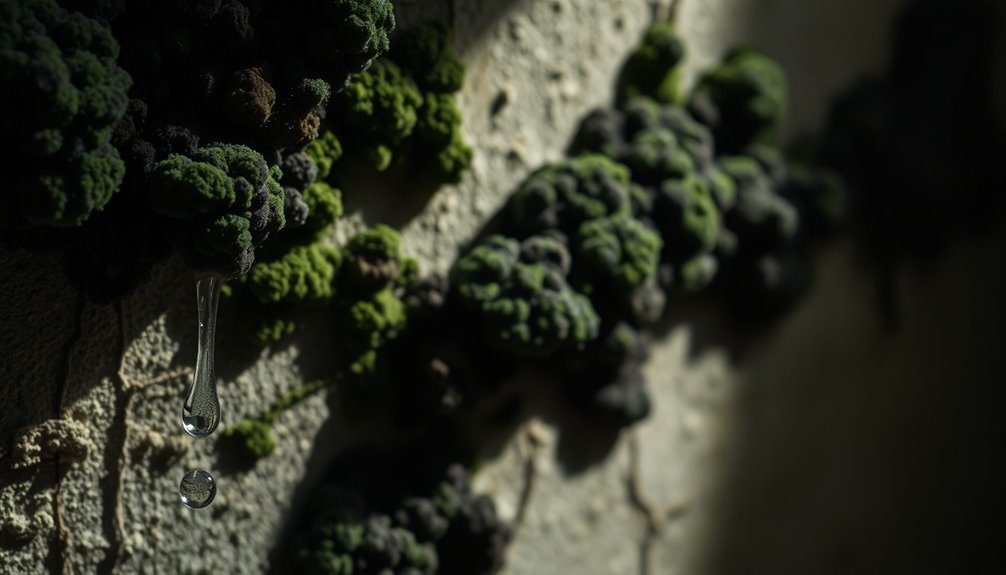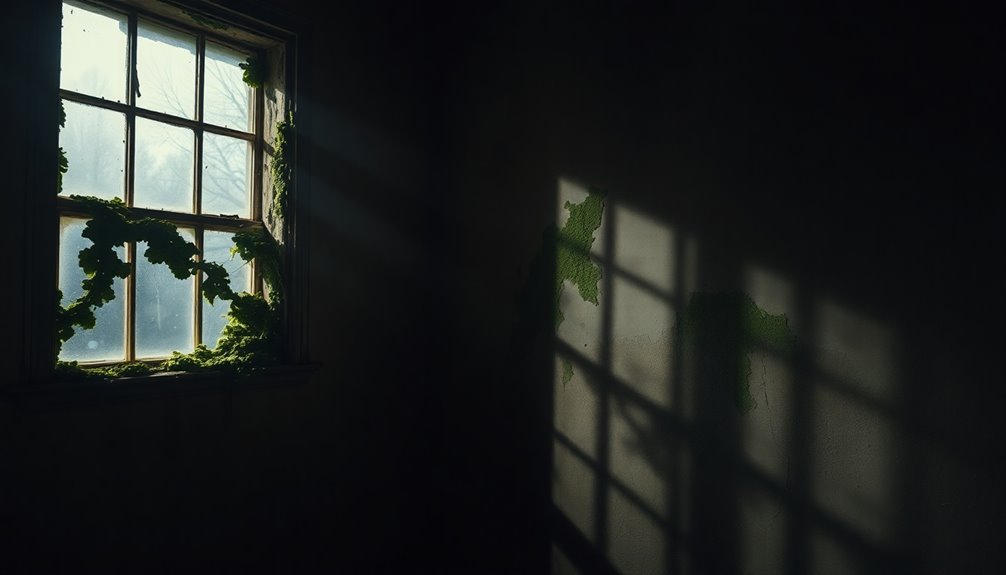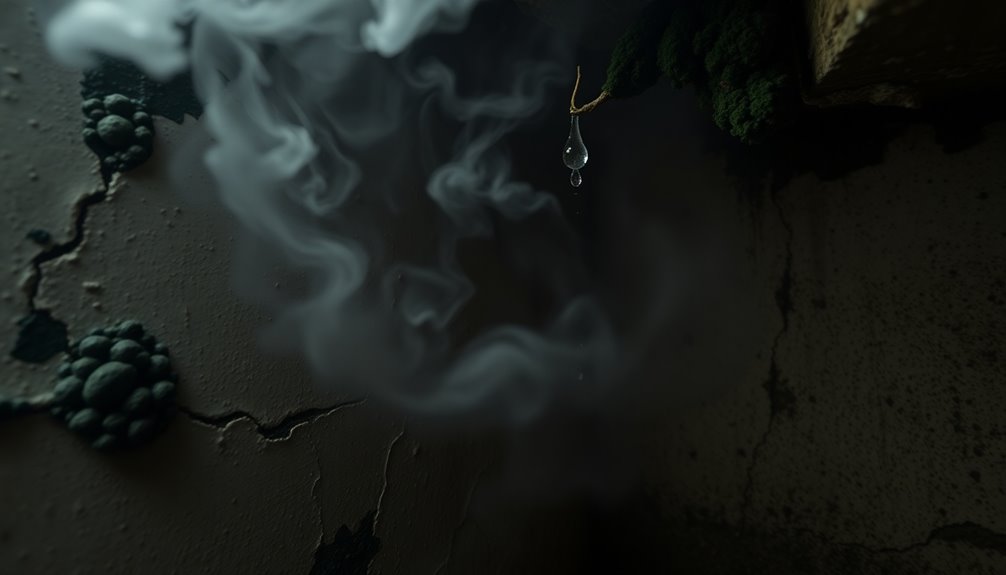Toxic mold, particularly black mold, gives off a musty, earthy odor that you might compare to damp wood or dirty socks. This smell comes from microbial volatile organic compounds released during mold growth. If you notice a strong, musty scent, especially in areas prone to moisture like bathrooms or basements, it could indicate hidden mold. It's crucial to address this quickly, as the presence of mold can pose serious health risks. Curious about the types of mold, their effects, or how to handle infestations? There's much more to uncover regarding mold and its implications.
Key Takeaways
- Toxic mold, especially Stachybotrys chartarum, emits a musty, earthy odor reminiscent of damp wood or sweaty socks.
- The smell is caused by microbial volatile organic compounds (mVOCs) released during mold growth.
- Stronger mold odors can resemble stale or fermented substances, indicating higher moisture levels.
- Musty smells often signal hidden mold growth and potential indoor air quality issues.
- Regular inspections in moisture-prone areas are essential for early detection of mold odors.
Introduction

Toxic mold smell can be a concerning sign in your home, indicating potential hidden mold growth. You might notice a musty odor, often linked to toxic molds like Stachybotrys chartarum. This smell can remind you of damp, rotting wood or even sweaty socks. It's crucial to recognize that this odor stems from microbial volatile organic compounds (mVOCs) released during mold growth.
If you detect persistent musty odors, don't ignore them; they could signal a serious issue affecting your indoor air quality. Mold thrives in damp areas, and the presence of these odors might be your first clue to hidden mold infestations. The intensity of the smell can vary based on the type of mold and its growth stage, but the health risks remain a constant concern. Symptoms of mold exposure can include respiratory problems, headaches, and allergic reactions. By addressing the source of the odor promptly, you can safeguard your health and maintain a healthier living environment. Don't let toxic mold take hold—act quickly if you sense that musty odor creeping into your space.
Description of the Smell

The musty odor of mold can be unmistakable and often lingers in areas where moisture accumulates. You might notice an earthy smell that's reminiscent of wet socks or rotten wood, which signals potential mold growth. This scent typically arises from decaying organic matter, and it's a clear indication that something isn't right in your environment.
As the mold infestation worsens, the odor can become even more intense, resembling stale smells or foul odors associated with fermented substances or spoiled food. These stronger smells indicate a more severe problem, requiring immediate attention.
One of the main culprits behind this unpleasant aroma is the release of microbial volatile organic compounds (mVOCs) produced by toxic mold during its growth. These compounds contribute significantly to the musty mold smell that permeates affected areas. The intensity of the odor varies depending on the type of mold, its growth stage, and the moisture levels present. If you detect such odors, it's crucial to investigate further to determine if you have a mold problem needing prompt remediation.
Source and Composition

Many people might not realize that the source of the musty smell in their homes often comes from specific types of mold, particularly Stachybotrys chartarum, commonly known as black mold. This toxic black mold emits a distinct, unpleasant odor that many associate with damp, decaying organic matter. The smell is primarily caused by microbial volatile organic compounds (mVOCs) released during mold growth and reproduction processes.
Different species of mold can produce varying odors, with some resembling rotting wood or fermenting substances. The intensity and composition of the smell are heavily influenced by environmental factors, such as moisture levels and the surfaces on which mold is growing. A strong musty odor typically indicates hidden mold growth somewhere in your home, which can pose health risks.
If you detect this musty smell, it's crucial to investigate further. Ignoring it could lead to more significant mold issues requiring professional remediation. Addressing moisture levels and identifying the source of the odor can help prevent further mold growth, ensuring your living environment remains safe and healthy.
Typical Scenarios or Environments

You might be surprised to learn that certain environments are particularly susceptible to the growth of toxic mold, leading to that unmistakable musty smell. Areas with high humidity, like basements and bathrooms, often become breeding grounds for toxic mold, especially after incidents of water damage. In these damp conditions, you might notice a persistent musty odor that signals a bigger problem.
If you've experienced flooding or leaks, you should be especially vigilant. The smell of toxic mold can intensify in enclosed spaces, hinting at hidden mold growth behind walls or ceilings that you can't see. This odor serves as a crucial warning sign for potential health risks. Regular mold inspections in areas known for moisture problems are essential. If you detect that musty smell, it's time to call in professional mold assessors to evaluate the situation.
Ignoring the signs can lead to serious health issues, so don't take any chances. Addressing the source of the moisture and the mold promptly can help protect your home and your health from the dangers of toxic mold.
Emotional or Cultural Associations

Experiencing the musty odor of toxic mold can trigger a cascade of emotions, often rooted in feelings of unease and discomfort. This smell isn't just unpleasant; it carries deep associations with decay and uncleanliness, making you question the safety and livability of your environment. Culturally, the presence of mold often signals neglect, creating a stigma that can be hard to shake off.
For many, this musty odor can evoke personal experiences or memories tied to health issues caused by mold exposure, intensifying your emotional response. You might recall a family member suffering from allergies or respiratory problems after being in a moldy space. These feelings are compounded by the fear of potential health risks, making it difficult to discuss mold-related issues openly.
As a result, the fear surrounding mold not only affects how you perceive your living situation but can also hinder your ability to seek help. In a society that values cleanliness, the musty odor of toxic mold becomes a powerful symbol of neglect and danger, making it crucial to address these emotional and cultural associations when dealing with mold in your home.
Health or Safety Considerations

Recognizing the musty odor of toxic mold is crucial, as it often signals serious health risks lurking in your environment. Black mold, specifically, is notorious for its harmful health effects, particularly when its smell becomes overwhelming. Prolonged exposure can lead to respiratory issues, such as coughing and throat irritation, which are especially concerning for those with weakened immune systems or pre-existing conditions like asthma.
Ignoring that musty odor isn't just unwise; it can result in chronic health problems over time. You might experience allergic reactions, including sneezing and itchy eyes, which can escalate for sensitive individuals. If you detect this smell, it's vital to conduct mold testing and mold inspection and testing right away. Early detection can help you identify hidden mold growth that compromises indoor air quality.
Once toxic mold is confirmed, immediate mold removal is necessary to safeguard your well-being. The longer you wait, the higher the risk of serious health complications. Don't underestimate the importance of addressing that musty odor—taking action can protect you and your loved ones from the dangers of toxic mold exposure.
Final Thoughts

Addressing the musty odor of toxic mold isn't just about immediate discomfort; it's about safeguarding your health and living environment. The presence of toxic mold, especially black mold, can pose serious health risks. This mold emits strong, unpleasant odors that often signal microbial volatile organic compounds (mVOCs) at work. If you notice a musty odor resembling damp, decaying organic matter or even sweaty socks, it's crucial to take action.
Ignoring these smells can lead to severe respiratory issues and other health problems due to prolonged exposure. Early detection is vital, as these odors can serve as alarms for hidden mold growth you may not see. The sooner you identify and intervene, the better your chances of protecting yourself and your loved ones.
Don't underestimate the power of your senses. If you smell unpleasant odors in your space, investigate further. Mold growth can escalate quickly, turning a minor issue into a major health hazard. By staying vigilant and proactive, you can safeguard your home and well-being against the dangers of toxic mold. So, trust your instincts and act swiftly when you detect that musty odor.
Frequently Asked Questions
What Does Harmful Mold Smell Like?
When you encounter harmful mold, you might notice a musty, earthy smell that reminds you of dampness or decay. It could smell like rotten wood or decaying leaves. In more severe cases, the odor can be even stronger, resembling sweaty socks or rotten meat. If you detect a persistent musty scent, especially in damp areas, it's crucial to investigate further, as it often indicates hidden mold growth that needs addressing.
How Do You Know if It's Toxic Mold?
To determine if mold is toxic, you should look for specific signs. If you notice a persistent musty odor, it's a red flag. Check for visible mold growth, especially in damp areas like basements or bathrooms. Pay attention to any health symptoms you experience, like respiratory issues or allergic reactions, as these can indicate mold exposure. If you suspect toxic mold, it's best to consult a professional for thorough testing and removal.
Can You Smell Mold Behind Walls?
Yes, you can smell mold behind walls, especially if it's growing in hidden spaces. If you notice a persistent musty odor, it might indicate mold presence even if you can't see it. It's crucial to trust your senses; that smell often points to moisture issues or hidden mold growth. Don't ignore it—address potential water damage and consider getting a professional inspection to ensure your environment stays healthy and safe.
Is It Safe to Sleep in a Room That Smells Like Mold?
Sleeping in a room that smells like mold isn't safe. That musty odor often signals the presence of mold, which can lead to allergic reactions and respiratory issues. If you notice this smell, it's best to avoid the area until you identify and address the source. Prolonged exposure can worsen health problems, so don't hesitate to seek professional help to ensure your sleeping environment is safe and healthy. Your well-being matters!









